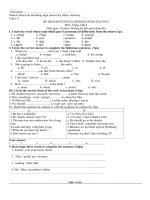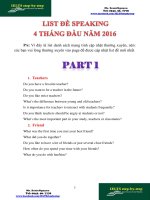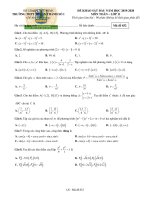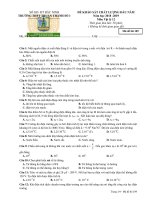Bộ đề KSCL đầu năm lớp 11
Bạn đang xem bản rút gọn của tài liệu. Xem và tải ngay bản đầy đủ của tài liệu tại đây (106.88 KB, 10 trang )
ĐỀ THI KHẢO SÁT CHẤT LƯỢNG ĐẦU NĂM
MÔN: TIẾNG ANH 11
(Thời gian làm bài: 60 phút)
MÃ ĐỀ 1
Mark the letter A, B, C, or D on your answer sheet to indicate the word whose
underlined part pronounced differently from the rest.
Question 1. A. included
B. wanted
C. decided
D. noticed
Question 2. A. allow
B. tomorrow
C. slowly
D. below
Mark A,B,C or D to indicate the word whose main stress differs from the rest.
Question 3. A. struggle
B. survive
C. enlarge
D. occur
Question 4. A. reliable
B. conventional
C. preservative
D. intellectual
Identify the underlined word or phrase that must be changed in order for the
sentence to be corrected
Question 5: These exercises look easy, but they are very relatively difficult for us.
A
B
C
D
Question 6: The sun releases large amounts of energetic every day
A
B
C
D
Question 7: Life began on our planet about 3,500 million years before.
A
B
C
D
Mark the letter A, B, C, or D on your answer sheet to indicate the most suitable
response to complete each of the following questions
Question 8: Kay: “I wouldn’t do that if I were you.” John: “ ”
A. Wouldn’t you? Why?
B. Would you, really?
C. I’d rather you didn’t.
D. It’s out of the question.
Question 9: Lucy: “You look really nice in that red sweater!” Sue : “”
A. Don’t mention it.
B. How dare you?
C. I’m afraid so.
D. Thank you.
Mark the letter A, B, C or D on your answer sheet to indicate the word(s) SIMILAR in
meaning to the underlined word(s) in each of the following questions.
Question 10: The lost hikers stayed alive by eating wild berries and drinking spring water.
A. revived
B. surprised
C. connived
D. survived
Trang 1
Question 11: Everything was in a thorough mess.
A. utter
B. full
C. complete
D. appalling
Mark the letter A, B, C, or D on your answer sheet to indicate the word or phrase
that is OPPOSITE meaning to the underlined part in each of the following
questions.
Question 12: Henry has found a temporary job in a factory.
A. eternal
B. genuine
C. permanent
D. satisfactory
C. humble
D. cunning
Question 13: Why are you being so arrogant?
A. snooty
B. stupid
Mark the letter A, B, C, or D on your answer sheet to indicate the sentence that is
closest in meaning to each of the following questions.
Question 14: Sam speaks Chinese well and his Japanese is good, too.
A. Sam is good at either Chinese or Japanese.
B. Not only Chinese but also Japanese Sam is good at.
C. Not only does Sam speak Chinese but also Japanese.
D. Not only does Sam speak Chinese well but he is also good at Japanese.
Question 15: It’s a bad line. Do you want me to give you a ring later?
A. Can I call you later?
B. I would like to give you a ring as a present.
C. Would you like to become my wife
D. Can I give the ring back to you later?
Question 16: Had she read the reference books, she would have been able to finish the test.
A. If she had read the reference books, she could finish the test.
B. Not having read the reference books, she couldn’t finish the test.
C. Although she didn’t read the reference books, she was able to finish the test.
D. Because she read the reference books, she was able to finish the test.
Mark the letter A, B, C, or D on your answer sheet to indicate the sentence that best
combines each pair of sentences in the following questions.
Trang 2
Question 17: We’d better leave them a note. It’s possible they’ll arrive later.
A. If they arrive late, we’d better leave them a note.
B. We’d better leave them a note as they possibly arrive later.
C. They’ll probably arrive later so that we’d better leave them a note.
D. We’d better leave them a note in case they arrive later.
Question 18: She prefers going to the library to staying at home.
A. She would rather go to the library than stay at home.
B. She likes nothing better than going to the library
C. She does not like either going to the library or staying at home.
D. She stays at home instead of going to the library.
Mark the letter A, B, C, or D to indicate the correct answer in each of the following
questions.
Question 19: Deborah is going to take extra lessons to
A. catch up on
B. put up with
Question 20: My class has three
A. presenters
what she missed when she was away.
C. cut down on
taking part in this year’s competition.
B. representatives
C. members
Question 21: In spite of her abilities, Laura has been
A. repetitive
B. repeatedly
Question 22: This is the school
A. which
D. take up with
D. boys
overlooked for promotion.
C. repetition
D. repeat
I used to study.
B. where
C. when
D. who
C. look
D. taste
Question 23: Don’t the kettle; it’s still hot.
A. touch
B. feel
Question 24: Policemen are sometimes on
A. force
B. alert
at night.
C. cover
Question 25: George won five medals at the competition. His parents
A. can’t be
B. can’t have
C. must have been
D. could have been
D. patrol
very proud of him.
Question 26: I’d rather you
A. hadn’t made
a noise last night; I couldn’t get to sleep.
B. wouldn’t take
C. didn’t take
D. haven’t take
Question 27: This is the third time James
the volunteer program to the village.
A. joins
C. has joined
B. joined
Question 28: The higher the content of carbon dioxide in the air is,
D. has been joining
.
A. the more heat it retains
B. the heat it retains more
C. it retains the more heat
D. more heat it retains
Question 29: By the time you got her letter, she
in Paris.
A. arriving
C. had arrived
Question 30
B. arrived
D. arrive
you help me to send this document to my office by fax?
A. Could
B. Should
C. Would
D. Can
Read the following passage and mark the letter A, B, C, or D on your answer sheet to choose the
word or phrase that best fits each of the numbered blanks from 31 to 35.
Mobile phones emit microwave radio emission. Researchers are questioning whether exposure to these
radio waves might…… (31) …to brain cancer. So far, the data are not conclusive. The scientific
evidence does not enable us to say with certainly that mobile phones are categorically……. (32) …. .
On the other hand, current researcher has not yet proved clear adverse effect associated with the
prolonged use of mobile phones.
Numerous studies are now going (33) in various countries. Some of the results are contradictory but
others have shown an association between mobile phone use and cancer. ……. (34) …, these studies
are preliminary and the issue needs further, long- term investigation.
Until the scientific date is more definite, it is prudent for people to try not to use mobile phone for long
periods of time. Don’t think that hands free phones are any safer either. At the moment, research is in
fact showing the opposite and they may be just as dangerous. It is also thought that young people…
(35) … bodies are still growing may be at particular risk.
Question 31: A. bring
B. lead
C. cause
D. produce
Question 32: A. risky
B. unhealthy
C. secure
D. safe
Question 33: A. on
B. by
C. through
D. about
Question 34: A. Additionally
B. However
C. While
D. Thought
Question 35: A. whose
B. that
C. with
D. as
Read the following passage and mark the letter A, B, C, or D on your answer
sheet to indicate the correct answer to each of the questions from 36 to 42.
Animation traditionally is done by hand- drawing or painting successive frame of an object, each
slightly different than the proceeding frame. In computer animation, although the computer may be
the one to draw the different frames, in most cases the artist will draw the beginning and ending
frames and the computer will produce the drawings between the first and the last drawing. This is
generally referred to as computer- assisted animation, because the computer is more of a helper than
an originator.
In full computer animation, complex mathematical formulas are used to produce the final sequences
of pictures. These formulas operate on extensive databases of numbers that defines the objects in the
pictures as they exist in mathematical space. The database consists of endpoints, and color and
intensity information. Highly trained professionals are needed to produce such effects because
animation that obtains high degrees of realism involves computer techniques from three- dimensional
transformation, shading, and curvatures.
High- tech computer animation for film involves very expensive computer systems along with special
color terminals or frame buffers. The frame buffer is nothing more than a giant image memory for
viewing a single frame. It temporarily holds the image for display on the screen.
A camera can be used to film directly from the computer’s display screen, but for the highest quality
images possible, expensive film recorders are used. The computer computers the position and colors
for the figures in the picture, and sends this information to the recorder, which captures it on film.
Sometimes, however, the images are stored on a large magnetic disk before being sent to the recorder.
Once this process is completed, it is replaced for the next frame. When the entire sequence has been
recorded on the film, the film must be developed before the animation can be viewed. If the entire
sequence does not seem right, the motions must be corrected recomputed, redisplayed, and
rerecorded. This approach can be very expensive and time- consuming. Often, computer- animation
companies first do motion tests with simple computer- generated line drawings before selling their
computers to the task of calculating the high- resolution, realistic- looking images.
Question 36. What aspect of computer animation does the passage mainly discuss?
A. The production procession
B. The equipment needed
C. The highest cost
D. The role of the artist
Question 37: According to the passage, in computer- assisted animation the role of the
computer is to draw the………….
A. first frame
B. middle frames
C. last frame
D. entire sequences of frames
Question 38: The word “they” in the second paragraph refers to…………………...
A. formulas
B. objects
C. numbers
D. database
Question 39: According to the passage, the frame buffers mentioned in the third paragraph are used
to………….
A. add color to the images
B. expose several frames at the same time
C. store individual images
D. create new frames
Question 40: According to the passage, the positions and colors of the figures in high- tech
animation are determined by…………
A. drawing several version
C. analyzing the sequence from different angles
B. enlarging one frame at a lime
D. create new frames
Question 41: The word “capture” in the fourth paragraph is closest in meaning to…………
A. separates
B. registers
C. describes
D. numbers
Question 42: According to the passage, how do computer- animation companies often test motion?
A. They experiment with computer- generated line drawings.
B. They hand- draw successive frames.
C. They calculate high- resolutions images.
D. They developed extensive mathematical formulas.
Read the following passage and mark the letter A, B, C, or D on your answer sheet to
indicate the correct answer to each of the questions from 43 to 50.
During the nineteenth century, women in the United States organized and participated in a large
number of reform movements, including movements to reorganize the prison system, improve
education, ban the sale of alcohol, grant rights to people who were denied them, and, most
importantly, free slaves. Some women saw similarities in the social status of women and slaves.
Women like Elizabeth Candy Stanton and Lucy Stone were feminists and abolitionists who
supported the rights of both women and blacks. A number of male abolitionists, including William
Lloyd Garrison and Wendell Phillips, also supported the rights of women to speak and to participate
equally with men in antislavery activities. Probably more than any other movement, abolitionism
offered women a previously denied entry into politics. They became involved primarily in order to
better their living conditions and improve the conditions of others.
When the civil war ended in 1865, the Fourteen and Fifteen Amendments to the Constitution
adopted in1868 and 1870 granted citizenship and suffrage
to blacks but not to women.
Discouraged but resolved, feminists worked tirelessly to influence more and more women to
demand the right to vote. In 1869, the Wyoming territory had yielded to demands by feminists, but
the states on the East Coast resisted more stubbornly than before. A women’s suffrage bill had been
presented to every Congress since 1878, but it continually failed to pass until 1920, when the
Nineteenth Amendment granted women the right to vote.
Question 43: With what topics is the passage primarily concerned?
A. The Wyoming Territory
C. Abolitionists
B. The Fourteenth and Fifteenth Amendments
D. Women’s suffrage
Question 44: The word “ban” in line 3 most nearly means to…………….
A. encourage
B. publish
C. prohibit
D. limit
Question 45. The word “supported” in line 6 could best be replaced by…………..
A. disregarded
B. acknowledged
C. contested
D. promoted
Question 46. According the passage, why did women become active in politics?
A. To improve the conditions of life that existed at the time.
B. To support Elizabeth Cady Stanton for president.
C. To be elected to public office.
D. To amend the Declaration of independence.
Question 47. What had occurred shortly after the Civil War?
A. The Wyoming Territory was admitted to the Union.
B. A women’s suffrage bill was introduced in Congress.
C. The eastern states resisted the end of the war.
D. Black people were granted the right to vote.
Question 48. What does the nineteenth Amendment guarantee?
A. Voting right for blacks
C. voting rights for women
B. Citizenship for blacks
D. Citizenship for women
Question 49. The word “it” in line 17 refers to……………
A. bill
B. Congress
C. Nineteenth Amendment
D. vote
Question 50. When were women allowed to vote throughout the United States?
A. After 1866
B. after 1870
C. after 1878
D. after 1920
MÃ ĐỀ 2
A. Choose the best answer.
1. All the teachers
him because he is well-behaved.
A. Loves
B. love
C. is loving
D. loved
2. She was listening to some music when she suddenly
a siren.
A. heard
B. hears
C. hearing
D. hear
3. She looked in her mirror
an ambulance behind her.
A. saw
B. and see
C. and was seeing
D. and saw
4. He often
to work by car everyday but today he
by bus.
A. goes/ goes
B. is going/ will go
C. went/ has gone
D. goes/ is going
5. When I was a child, I usually
fishing with my brother.
A. go
B. went
C. gone
D. use to go
6. We
dinner at home on Saturdays.
A. haven’t had
B. didn’t had
C. aren’t have
D. don’t have
7. While she
on the phone, the children
fighting and
a window.
A. talked / started / broke
B. was talking / started / broke
C. was talking / was starting / broke
D. was talking / was started / broke
8. It
me fifteen minutes to get to school every morning.
A. takes
B. took
C. has taken
D. taken
9. What
to you yesterday morning?
A. had happened
B. has happened
C. was happening
D. happened
10.
We were watching TV when the lights
out.
A. went
B. has gone
C. had gone
D. were going
11.
He used to talk to us for hours about all the interesting things he
in his life.
A. did
B. was done
C. had done
D. has done
12.
John
tennis once or twice a week.
A. usually play
B. is usually play
C. usually plays
D. have usually plays
13.
At 5 o’clock yesterday evening, I
my clothes.
A. am ironing
B. have ironed
C. was ironing
D. ironed
14.
It’s at least a month since
Tom.
A. I last seen
B. I last see
15.
C. I have last seen
D. I last saw
At the moment, John ____________his new car. He____________ his car on Sundays.
A. is washing / often washes
B. was washing / has often washed
C. washed / often washes
D. has washed / is often washing
16. Mary ___________ chocolate since she was a little girl.
A. has loved
B. loved.
C. Loves
D. had loved
17. A- Why are you filling that bucket with water? B- Because I____________ the car
A. am going to wash
B. will wash
C. will to wash
D. am being washed
18. Are you single or married? Is to ask about one’s____________.
A. nationality
B. marital status
C. address
19. I’ll tell Mary all the news when___________ her.
A. I will see
B. I am going to see
C. I see
20. I really enjoyed the fashion. It was great, ____________?
A. is it
B. isn’t it
C. was it
21. The____________ are those who don’t have jobs.
A. unemployees
B. Unemployed
C. Unemployment
22. My younger sister is____________ in picture stories.
A. interesting
B. interested
C. interests
23. I can’t remember____________ her somewhere.
A. see
B. seeing
C. to see
24. There’s____________ sugar in the bottle. We can’t make cakes.
A. a few
B. few
C. a little
25. This street is crowded____________ my students every morning.
A. By
B. in
C. At
26. I prefer cats____________ dogs. I hate dogs.
A. from
B. over
C. than
27. Someone____________ the tickets are free.
A. said me
B. said me that
C. told me
28. What’s the name of the man____________ gave you a lift ?
A. whose
B. Which
C. whom
D. occupation
D. I shall see
D. wasn’t it
D. unemployers
D. interest
D. saw
D. little
D. with
D. to
D. told to me
D. who
29. Lan is a woman____________ husband died last year.
A. Her
B. whom
C who
D. whose
30. This is the girl____________ you met yesterday.
A. her
B. whom
C. whose
31. If____________ the train, I’ll be in trouble.
A. I missed
B. I’ll miss
C. I miss
32. We haven’t got a lot of money. If____________ it, we could buy a new car.
A. we’d have
B. we had
C. we have
33. We last went to the cinema two months ago.
A. We haven’t gone to the cinema for two months.
B. We didn’t go to the cinema for two months.
C. We didn’t want to go to the cinema any more.
D. We stopped going to the cinema.
34. I have never seen such an interesting film before.
D. which
D. I would miss
D. we’ve got
A. This is the first time I have seen such an interesting film.
B. This film is the best I have ever seen.
C. This is the first time I saw such an interesting film.
D. This is the best film that I saw.
35. Eight years ago we started writing to each other.
A. We have rarely written to each other for eight years.
B. Eight years is a long time for us to write to each other.
C. We wrote to each other eight years ago.
D. We have been writing to each other for eight years.
36. My father hasn't smoked cigarettes for a month.
A. It's a month since my father last smoked cigarettes.
B. It's a month ago that my father smoked cigarettes.
C. It's a month that my father hasn't smoked cigarettes.
D. It's a cigarette that my father smoked a month ago.
37. I can’t put on these shoes. They are too small for me.
A. These shoes aren’t big enough for my feet.
B. My feet are too small to get in these shoes.
C. My feet aren’t big enough for these shoes.
D. These shoes are too small enough for my feet.
B. Use the correct form of verbs in brackets.
1. In all the world, there (be) ____________ only 14 mountains that (reach) ____________ above 8,000
meters.
2. The war (break) ____________ out three years ago.
3. When I (come) ____________ she (leave) ____________ for Dalat ten minutes ago.
4. Be quiet! The baby (sleep) ____________
5. Right now I (attend) ____________ class. Yesterday at this time I (attend) ____________ class.
6. When I (arrive) ____________ the dinner (already, begin) ____________.
7. We seldom (eat) ____________ before 6. 30
8. I (not hear) ____________ about that doctor yet.
9. Listen! I (think) ____________ someone (knock) ____________ at the front door.
10.
Last night we (watch) ____________ TV when the power (fail) ____________.
------------------- THE END-------------------









